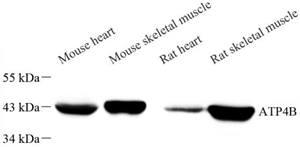Anti-Hydrogen Potassium ATPase Beta/ATP4B Rabbit pAb (100 μl)
| Reactivity: | M,R |
| Applications: | WB |
| Host Species: | Rabbit |
| Clonality: | Polyclonal |
| Full Name: | Hydrogen Potassium ATPase Beta/ATP4B rabbit polyclonal antibody |
Gene Name: | Potassium-transporting ATPase subunit beta |
Synonyms: | Gastric H(+)/K(+) ATPase subunit beta, Proton pump beta chain, Atp4b, Parietal cell antigen, Gastric hydrogen potassium ATPase, Proton pump |
Immunogen: | Recombinantproteincorresponding to Mouse Hydrogen Potassium ATPase Beta/ATP4B |
Isotype: | IgG |
Purity: | Affinity purification |
Predicted MW. | 34 kDa |
Observed MW. | 43 kDa |
Uniprot ID: | P50992, P18598 |
Product Usage Information
Applications | Species | Dilution | Positive Sample |
WB | Mouse, Rat | 1: 500-1: 1000 | heart, skeletal muscle |
Background
The hydrogen/potassium ATPase, or gastric proton pump, belongs to a family of P-type cation-transporting ATPases. This family of ATPases shares a number of functional and structural similarities including the common feature of consisting of an alpha and beta subunit. Like the ubiquitous sodium/potassium ATPase, the hydrogen/potassium ATPase consists of a large transmembrane catalytic subunit, termed the alpha- subunit which contains sites for ATP binding and phosphorylation, and an associated smaller glycoprotein, termed the beta-subunit which may play a role in maintaining the structural and functional integrity of the complex.
Images
| Western blot analysis of ATP4B (GB111711) at dilution of 1: 500 |
Storage
| Storage | Store at -20°C for one year. Avoid repeated freeze/thaw cycles. |
| Storage Buffer | PBS with 0.02%sodium azide,100 μg/ml BSA and 50% glycerol. |




